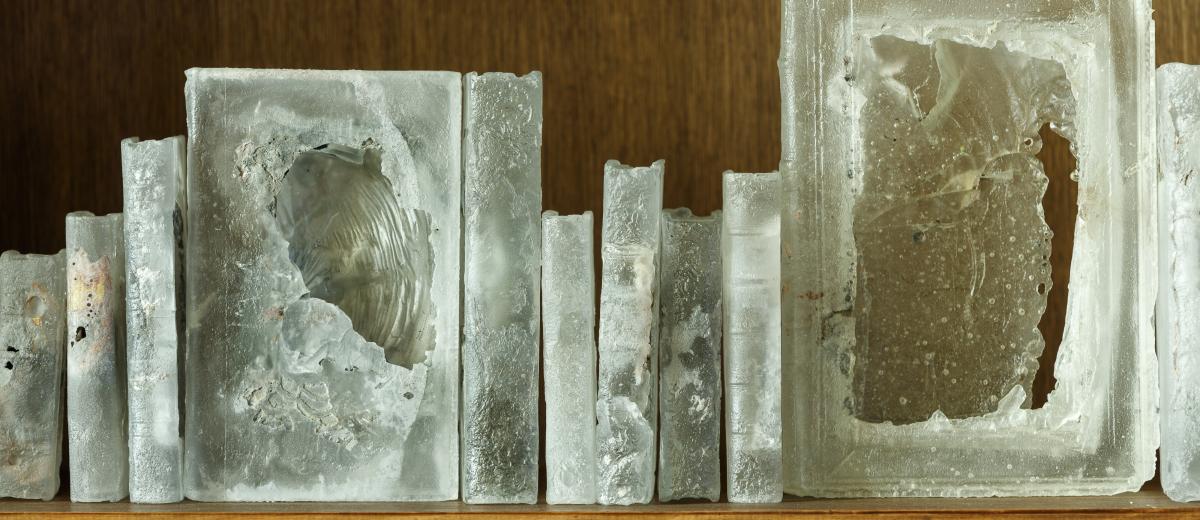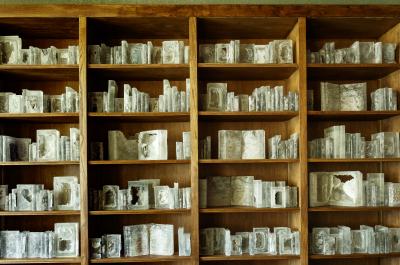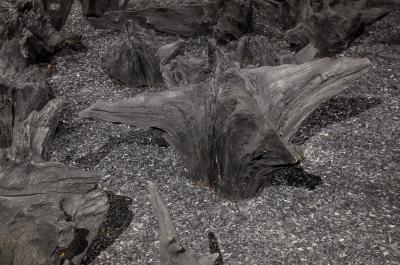Chateau
Pascal Convert
"Bibliothèque cristallisée" and "Ceux de 14"
published at 27/01/2020

Bibliothèque cristallisée
Spirituality, memory and meaning are at the heart of Pascal Convert’s work, which is both mysterious and profound. His work is essentially about memory and a refusal to forget. It sustains unique links with everything that has disappeared, both objects and beings. It often uses a process of crystallisation: molten glass is poured onto objects and, little by little, it attacks the material of the books or the wood of the sculptures, as if it were a form of transubstantiation, a unique alchemy that preserves the soul of the text.
“Crystallisation of a lost book” involves destroying a book and its contents with molten glass which gradually takes the place of the book. It results in a ghost object, a crystallised work that holds vitrified memories. The carbonised remains of the original book remain at the heart of the sculpture.
Memory and traces – linked to the theme of war, destruction and resistance – are the omnipresent themes of Pascal Convert’s work. “He often uses processes of memory and replication to reveal the traces left behind by history using materials such as wax, metal or glass. With the help of a master glassmaker, he creates a transmuted copy of the books, simultaneously causing the destruction of the originals. Once cooled, a glass replica of each book remains, frozen for eternity, yet preserving within it a vestige of the original and its destruction by fire. These fragments evoke the innumerable libraries burnt by totalitarian powers.”
In the spirit of poetic justice, these fire crystallised books will be shown in the Broglie family’s library in the Château, which was destroyed in a fire in 1957.
CEUX DE 14
Convert will also be showing his Souches – tree stumps from the battlefield of Verdun which have either been coated with Indian ink or vitrified. Poignant and full of superimposed memories, they make a powerful impression on the viewer.
“The stump is an object of both depth and extension, it comes from the roots and moves towards the branches. It holds within it enormous energy, but this is released into its branches, its tentacles, its sea urchin’s spines. It also evokes life in motion, its tangle of dynamic disturbances stopped by life itself; its fossilised appearance already mineralised. Its artistic shape makes it a carved, ornamental, excessively precise and precious object, but its physical bulk, stony and torn, makes it something that effortlessly evokes the wreckage of a catastrophe of biblical proportions. As an organ of growth, the stump is as necessary as it is trivial when merely a lightening-struck remnant. It is just as meaningful in the ground where it grows, as it is surprising and absurd when left lying around on the ground. The stump is an organic crystallisation of time, because it holds within it all the creation and growth of the tree that it bears. But it is also a three-dimensional net, the sculptural foundation and visual representation of the space that the tree will eventually occupy.” Georges Didi-Huberman, La demeure, la souche, apparentements de l’artiste, 1999.
BIOGRAPHICAL NOTES
Pascal CONVERT
FRANCE


The son of an artist, Pascal Convert was born in 1957 in Mont-de-Marsan. He is a visual artist, writer and director, and defines his work as the archaeology of architecture, childhood, history, the body and time. He uses materials such as glass and wax to evoke the passage of time, light and the lasting effects of the past. In 1987, while he was living in Bordeaux, he covered the wooden panelling in one room of his apartment with plate glass, which formed the first in his series entitled Appartement de l’artiste. In 1989 and 1990 he was resident at the Villa Médicis in Rome, and in 1992 his first major solo exhibition was held at the CAPC (Contemporary Art Museum) in Bordeaux. In 1997 he was invited by the philosopher and art historian Georges Didi-Huberman to take part in the L’Empreinte exhibition at the Centre Pompidou alongside Giuseppe Penone, Man Ray, Alain Fleischer and others. Georges Didi-Huberman would go on to write several books about Convert’s work (published by Éditions de Minuit) and include him in numerous exhibitions. In 2002 he unveiled his memorial to resistance fighters and hostages, the Monument à la mémoire des résistants et otages fusillés au Mont Valérien entre 1941 et 1944 (Mémorial de la France combattante, Suresnes). This was a commission by the French Ministry of Defence as suggested by French lawyer and politician Robert Badinter. Opposite the chapel where they were held before they were taken to the place of execution, Pascal Convert erected a 2.7m x 2.18m bronze bell engraved with the names of those who were killed . In 2003, as a continuation of this work, he made a documentary about the victims, Mont Valérien, aux noms des fusillés.
In 2007 his exhibition Lamento at Mudam in Luxembourg featured wax sculptures inspired by iconic press photos: La Pietà du Kosovo (1999-2000), based on a photo taken by Georges Mérillon, La Madone de Bentalha (2001-2002), based on a photo taken by Hocine Zaourar, and La Mort de Mohamed Al Dura (2002-2003), based on stills from a video by Talal Abou Rahmed. These sculptures have been widely exhibited at the United Nations, in Montreal, in Switzerland and in Italy. In the same year, he published a biography of Joseph Epstein, leader of the communist resistance in Paris, who was shot at Mont Valérien in 1944.
In 2008, he completed a set of stained glass windows for the abbey church of Saint Gildas des Bois (Loire-Atlantique). He then exhibited a huge crystal sculpture Le Temps scellé: Joseph Epstein et son fils, in the Force de l’Art exhibition at the Grand Palais in Paris in 2009. He again made a documentary film, Joseph Epstein: bon pour la légende. After four years of work, he published a new biography, Raymond Aubrac: résister, reconstruire, transmettre (Seuil, 2011), and made two documentary films about this leader of the French Resistance. Two years later the autobiographical story La Constellation du Lion (Grasset) was published. In 2014, he took part in the Busan Biennale in South Korea and the group exhibition La Guerre qui vient n’est pas la première: 1914-2014 at the Museum of Modern and Contemporary Art of Trento and Rovereto in Italy.
In 2016, he took part in the interdisciplinary exhibition, Soulèvements, at the Jeu de Paume arts centre. The highlight of that year was an invitation from the French ambassador to Afghanistan to commemorate the 15th anniversary of the destruction of the Buddhas of Bamiyan by the Taliban. Convert mounted an expedition in association with Iconem, an organisation that specialises in conflict zone archaeology. Using drones, he scanned the whole of the cliff face in Bamiyan to produce images that are now freely available to the global scientific community. Using a high-resolution camera, he made a “photographic impression” of the place where the monumental sculptures were carved about 1,600 years ago.
In 2019, the Éric Dupont Gallery dedicated a solo exhibition entitled Trois arbres to his work. Working with birch bark from Crematorium V at Auschwitz-Birkenau, a nuked cherry tree from Hiroshima, and the stone tree of life carvings found on Armenian khachkars, Pascal Convert used an archaeological investigation of family, culture and history to try to re-imagine that which has survived the destruction of our recent history.


